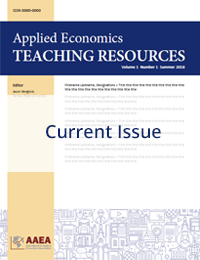Teaching and Educational Methods
Enhancing the Teaching of Product Substitutes/Complements: A Pedagogical Note on Diversion Ratios
Oral Capps, Jr.(a) and Senarath Dharmasena(a)
(a)Texas A&M University
JEL Codes: D10, D11, D12, D19
Keywords: Diversion ratios, demand systems, cross-price elasticities, identification of next-best substitutes
First Published Online: November 30, 2022
Volume 1, Issue 1
Abstract
Application of diversion ratios in demand analysis has received little attention. Even microeconomic textbooks typically do not address this topic. The literature review presented here shows use of diversion ratios, along with cross-price elasticities, to study the price effects associated with mergers and acquisitions, a practice recommended to measure product substitutability/complementarity. With the aim of expanding experiential learning in the fields of applied economics, agricultural economics, and agribusiness, this article demonstrates how diversion ratios can be calculated from any uncompensated own-price and cross-price elasticity matrix derived from the analysis of demand systems, and it discusses the teaching of this concept in the classroom.Â
References
Abere, A., O. Capps Jr., J. Church, and A. Love. 2002. “Estimating the Effect on Market Power of the Proposed Acquisition by the Coca-Cola Company of Cadbury Schweppes’s Carbonated Soft Drinks in Canada.” In Contributions to Economic Analysis: Measuring Market Power, edited by Daniel J. Slottje, 233–294. North-Holland, Elsevier.
Ault, R.W., T.R. Beard, J.D. Jackson, and R.P. Saba. 2005. “On the (Mis)Use of Cross-Price Effects to Gauge the Effectiveness of Smokeless Tobacco in Smoking Cessation: A Comment of Bask and Melkersson.” European Journal of Health Economics 50:83–86.
Banks, J., R. Blundell, and A. Lewbel. 1997. “Quadratic Engel Curves and Consumer Demand.” Review of Economics and Statistics 79(4):527–539.
Barnett, W.A., and A. Serletis. 2008. “Consumer Preferences and Demand Systems.” Journal of Econometrics 147:210–224.
Barten, A.P. 1964. “Consumer Demand Functions under Conditions of Almost Additive Preferences.” Econometrica 32(1/2):1–38.
Barten, A.P. 1993. “Consumer Allocation Models: Choice of Functional Form.” Empirical Economics 18:129–158.
Christensen, L.R., D.W. Jorgenson, and L.J. Lau. 1975. “Transcendental Logarithmic Utility Functions.” American Economic Review 65(3):367–383.
Deaton, A., and J. Muellbauer. 1980. “An Almost Ideal Demand System.” American Economic Review 70(3):312–326.
Dharmasena, S., and O. Capps, Jr. 2012. “Intended and Unintended Consequences of a Proposed National Tax on Sugar-Sweetened Beverages to Combat the U.S. Obesity Problem.” Health Economics 21:669–694.
Lewbel, A., and K. Pendakur. 2009. “Tricks with Hicks: The EASI Demand System.” American Economic Review 99(3):827–863.
Pittman, G.F. 2004. “Drivers of Demand, Interrelationships and Nutritional Impacts within the Non-alcoholic Beverage Complex.” Unpublished Ph.D. diss., Texas A&M University.
Shapiro, C. 1996. “Mergers with Differentiated Products.” Antitrust (Spring 1996): 23–30.
Smith, T.A., B.H. Lin, and J.Y. Lee. 2010. Taxing Caloric Sweetened Beverages: Potential Effects on Beverage Consumption, Calorie Intake and Obesity. USDA-ERS Economic Research Report No. 100. U.S. Department of Agriculture, Economic Research Service. https://papers.ssrn.com/sol3/papers.cfm?abstract_id=2118636.
Theil, H. 1965. “The Information Approach to Demand Analysis.” Econometrica 33(1):67–87. U.S. Department of Justice and Federal Trade Commission. 2010. Horizontal Merger Guidelines. https://www.ftc.gov/sites/default/files/attachments/merger-review/100819hmg.pdf.
Werden, G. 1998. “Demand Elasticities in Antitrust Analysis.” Antitrust Law Journal 66(2):363–414.
Willig, R.D. 1991. Merger Analysis, Industrial Organization Theory, and Merger Guidelines. In Brookings Papers on Economic Activity: Microeconomics, edited by Martin Neil Baily, 281–332. Washington, D.C.: Brookings Institution. https://www.brookings.edu/bpea-articles/merger-analysis-industrial-organization-theory-and-merger-guidelines/.
Yuan, Y., O. Capps, Jr., and R.M. Nayga. 2009. “Assessing the Demand for a Functional Food Product: Is There Cannibalization in the Orange Juice Category?” Agricultural and Resource Economics Review 38(2):153–165.Page | 45 Volume 1, Issue 1, May 2019
Zhen, C., M.K. Wohlgenant, S. Karns, and P. Kaufman. 2011. “Habit Formation and Demand for Sugar-Sweetened Beverages.” American Journal of Agricultural Economics 93(1):175–193
Articles in this issue
Job Attribute Preferences of Undergraduate Agricultural Majors—Do They Match with Careers in Grain Merchandising?
Keith D. Harris and Brian C. Briggeman
Calculating and Interpreting Percentage Changes for Economic Analysis
Matthew A. Andersen
Assessing Student Learning Using a Digital Grading Platform
Andrew W. Stevens
Enhancing the Teaching of Product Substitutes/Complements: A Pedagogical Note on Diversion Ratios
Oral Capps, Jr. and Senarath Dharmasena
Teaching Undergraduate Economics: Emphasize Early the Meaning of Vertical Distances and of Their Summation Over Quantities
Matthew G. Interis
Occupational Health and Safety Issues at Agribusiness Retailers
Erik Hanson and Michael Boland
Let's take a moment to celebrate great teaching!
James A. Sterns
Moneyball in the Academy: Whiffing on the Quality of Education?
Paul N. Wilson


